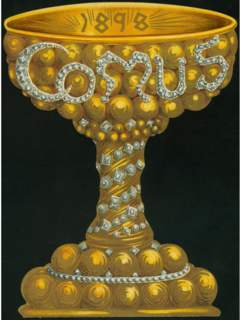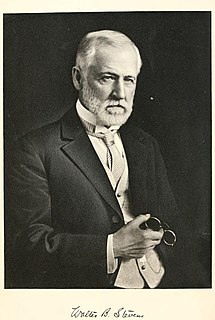George Albert Raoul Soulie, known as George Soulie (1844-1919) was a French-born artist living and working in New Orleans, Louisiana, and St. Louis, Missouri.
Contents

George Albert Raoul Soulie, known as George Soulie (1844-1919) was a French-born artist living and working in New Orleans, Louisiana, and St. Louis, Missouri.

He was born in December 1844 in Paris, Ile-de-France. He married Ernestine Dupaquier in Paris on January 4, 1868, to whom was born one son. He then was wed to Louise Broulet in 1872, and they had two children. He died on September 15, 1919, at the age of 74. [1] [2]
Soulie learned the profession of sculptor and painter in Paris, then served in the army during the Franco-Prussian War of 1870, after which he emigrated to New Orleans. There he established an atelier, or workshop, where he first devoted his time to making ornaments and models in papier-maché for the floats in Mardi Gras parades. Later he built a complete parade from a superstructure of woodwork and papier-maché, executed by the same set of workmen, under one superintendent. He remained the sole contractor and builder for thirty years. [3]
George R. Larriue wrote for the New Orleans Times-Democrat that: [3]
For seven or eight months preceding the Carnival Mr. Soulie has a force of from thirty to thirty-five people constantly at work putting up the woodwork, making flowers, decorations, signs, floats and arranging and executing the details that go toward the construction of a scene car or float. His plant is complete . . . But it is also . . . private.
He and his son, Henry Soulé, now his assistant, would draw the plans, and the father would make models in clay, "the figures of horses, lions, dogs or other animals, as well as birds, statuary, dragons and other ornaments and fixtures." [3]
He then cast plaster models which were "given over to a corps of ladies for the purpose of stamping the molds with papier-maché," and, when dried, the "molds are removed and the figure is complete and ready to be mounted on the wooden frame," then "decorated in keeping with the original design or drawing." [3]
Soulie did this kind of work in New Orleans for more than three decades, Larriue wrote, modeling "every figure" on from 70 to 75 floats every year. [3]
In 1879 he also proposed to do similar work for the Veiled Prophet Parade in St. Louis, Missouri., and he signed a contract "to paint, decorate, and fix up generally in first-class style twenty-one chariots, or floats" for $630. He worked for three weeks, then was discharged by Superintendent Daniel E. Carroll. [4]
Because the St. Louis Prophets were supposed to be nameless, "every effort" was made to keep the matter quiet, but Soulie filed suit against John G. Priest, president; Frank Galennie, secretary; Daniel Carrol, superintendent; Charles E. Slayback and Preston T. Slayback. [4] The St. Louis Daily Globe Democrat reported that after "the indignant artist threatened to reveal all he knew concerning the Prophets and their identity," a "consultation of the high-muck-a-mucks of the V.P.'s was held," they offered $200, Soulie withdrew the suit, "the bounced artist promised to remain true to his plighted word not to squeal, and the awful mystery which surrounds to Prophets" remained "as impenetrable as before." [5]

A handicraft, sometimes more precisely expressed as artisanal handicraft or handmade, is any of a wide variety of types of work where useful and decorative objects are made completely by one’s hand or by using only simple, non-automated related tools like scissors, carving implements, or hooks. It is a traditional main sector of craft making and applies to a wide range of creative and design activities that are related to making things with one's hands and skill, including work with textiles, moldable and rigid materials, paper, plant fibers,clay etc. One of the oldest handicraft is Dhokra; this is a sort of metal casting that has been used in India for over 4,000 years and is still used. In Iranian Baluchistan, women still make red ware hand-made pottery with dotted ornaments, much similar to the 5000-year-old pottery tradition of Kalpurgan, an archaeological site near the village. Usually, the term is applied to traditional techniques of creating items that are both practical and aesthetic. Handicraft industries are those that produce things with hands to meet the needs of the people in their locality without using machines.

The Mistick Krewe of Comus, founded in 1856, is a New Orleans, Louisiana, Carnival Krewe. It is the oldest continuous organization of New Orleans Mardi Gras festivities.

Rex is a New Orleans Carnival Krewe which stages one of the city's most celebrated parades on Mardi Gras Day. Rex is Latin for "King", and Rex reigns as "The King of Carnival".

The St. Louis Post-Dispatch is a major regional newspaper based in St. Louis, Missouri, serving the St. Louis metropolitan area. It is the largest daily newspaper in the metropolitan area by circulation, surpassing the Belleville News-Democrat, Alton Telegraph, and Edwardsville Intelligencer. The publication has received 19 Pulitzer Prizes.

Sparty is the mascot of Michigan State University. Sparty is usually depicted as a muscular male Spartan warrior/athlete dressed in stylized Greek costume. After changing the team name from "Aggies" to "Spartans" in 1925, various incarnations of a Spartan warrior with a prominent chin appeared at university events and in university literature. In 1943, MSU art professor Leonard D. Jungwirth designed a statue for the university, which had to be cast in terra cotta because of World War II rationing. In 2005, the university replaced Jungwirth's original statue with a bronze replica, moving the original indoors to protect it from the elements.
Hashim, better known as al-Muqanna‘ was leader of an anti Islamic revolt who claimed to be a prophet, and founded a religion which was a mixture of Zoroastrianism and Islam. He was a chemist, and one of his experiments caused an explosion in which a part of his face was burnt. For the rest of his life he used a veil and thus was known as "al-Muqanna‘". Said Nafisi and Amir-Hossein Aryanpour have written about him in the "Khorrām-Dīnān" armies.

Fair St. Louis is an annual festival held during the United States Independence Day holiday in downtown St. Louis, Missouri, at the Gateway Arch National Park. It is funded by the Veiled Prophet Organization.

Louis Baunard was a rector of the Catholic University of Lille and historian.

The Veiled Prophet Parade and Ball was a yearly civic celebration in St. Louis, Missouri, over which a mythical figure called the Veiled Prophet presided. The first events were in 1878.

Frank Bernard Nuderscher was an American illustrator, muralist, and painter of the American Impressionism style. He was called the "dean of St. Louis artists" for his leadership in the Missouri art community.

Carl Gutherz was a painter, part of the Symbolist movement in the United States during the 19th century.
Knights of Babylon is a New Orleans Mardi Gras krewe that was founded in 1939.

Alonzo William Slayback (1838–1882), a lawyer, was an officer in the Confederate Army and a founder of the Veiled Prophet Parade and Ball in St. Louis, Missouri. He was shot and killed in self-defense by the managing editor of the St. Louis Post-Dispatch.

Charles E. Slayback (1840-1924) was a grain merchant in New Orleans, Louisiana, and St. Louis, Missouri. He was a founder of St. Louis's Veiled Prophet Organization.
John Hower Tice, known as John H. Tice, (1809-1883) was an American weather forecaster, educator, and author.

John G. Priest (1822–1900) was a businessman and social and civic leader in St. Louis, Missouri, in the latter part of the 19th Century. He was the first Veiled Prophet representation of that city.

Walter B. Stevens (1848-1939) was a journalist and secretary and publicity director of the Louisiana Purchase Exposition Company and the author of books on the history of Missouri.

Albert Estopinal was an American Civil War veteran who served seven terms as a U.S. Representative from Louisiana from 1908 to 1919.